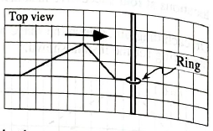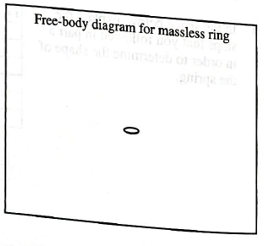
We begin by considering the forces exerted on a ring that is connected to a spring and that is free to slide along a rod. (See the top view diagram at right.)
Assume that the ring is massless and that the rod is frictionless.

- What is the n, force on the ring? (Hint: Consider what happens to the net force on an object as its mass approaches zero.) Explain.
Does the net force on a massless ring depend on the acceleration of the ring? Explain
What is the magnitude of the gravitational force exerted on the ring? (Recall that the ring is massless.)

Check that your free-body diagram is consistent with your answers to pans i and ii.
Would your answer above differ if you considered an instant when the free end was not at its farthest point from its equilibrium position? Explain.

Want to see the full answer?
Check out a sample textbook solution
Chapter 23 Solutions
Tutorials in Introductory Physics
Additional Science Textbook Solutions
College Physics (10th Edition)
An Introduction to Thermal Physics
Essential University Physics: Volume 1 (3rd Edition)
Physics for Scientists and Engineers: A Strategic Approach, Vol. 1 (Chs 1-21) (4th Edition)
College Physics
University Physics with Modern Physics (14th Edition)
- Use the worked example above to help you solve this problem. A block of mass m1 = 1.72 kg, initially moving to the right with a velocity of +3.95 m/s on a frictionless horizontal track, collides with a massless spring attached to a second block of mass m2 = 2.01 kg moving to the left with a velocity of −2.83 m/s. The spring has a spring constant of 6.33 x102 N/m. (a) Determine the velocity of block 2 at the instant when block 1 is moving to the right with a velocity of +3.00 m/s. (Indicate the direction with the sign of your answer.) (b) Find the compression of the spring.arrow_forwardA ball of mass m moving with velocity v⃗ i strikes a vertical wall as shown in (Figure 1). The angle between the ball's initial velocity vector and the wall is θi as shown on the diagram, which depicts the situation as seen from above. The duration of the collision between the ball and the wall is Δt , and this collision is completely elastic. Friction is negligible, so the ball does not start spinning. In this idealized collision, the force exerted on the ball by the wall is parallel to the x axis.What is the magnitude F of the average force exerted on the ball by the wall?arrow_forwardis my answer and process correct in the pic? what is the answer to this? Consider the percentage difference between the and for the first two parts of the laboratory when known forces are balanced. A difference of 0.5% or less is excellent, a difference of 1.0% or less is good, and a difference of 2% or less is acceptable. Based on these criteria, describe your results for the first two parts of the laboratory and defend your statement.arrow_forward
- Please explain it short and easy to understand (The picture is what the experiment look like) (Please don't explain it by giving the formulas because I don't understand) It is all related. What is the effect of increasing and decreasing the altitude where the experiment takes place? Why? (I really don't understand this question because it does not change anything when increase or decrease it) What is the effect of increasing or decreasing the mass of the cannon ball?(I think the effect is that with air resistance, increasing the mass will increase the range of the cannonball because the object is heavier. Is it correct?)arrow_forwardShow your complete solution, including diagram.2. A linear spring of stiffness k is to be designed to atop a 20-Mg railroad car traveling at 8 km/h within 400 mm after impact. Find the smallest value of k that will produce the desired result.arrow_forwardSuppose a cube 1-cm long on each side were scaled up to a cube 10-cm on each edge a) what would be the volume of the scaled up cube? B) what would be its cross-sectional surface area? C) what is the total surface area? Show your work, formulas and calculations to support your results be sure to include the appropriate units for volume and areaarrow_forward
- An object moves on a flat surface with an acceleration of constant magnitude. If the acceleration is always perpendicular plane and measures the angle at which the block begins to slide. He reports that the coefficient of static friction was 0.25 in his experiments. At what angle did Leonardo’s blocks begin to slide? Show your work and explain.arrow_forwardUse the worked example above to help you solve this problem. Two billiard balls of identical mass move toward each other as shown in the figure. Assume that the collision between them is perfectly elastic. If the initial velocities of the balls are v1i = +25.2 cm/s and v2i = −20.3 cm/s, what are the velocities of the balls after the collision? Assume friction and rotation are unimportant. (Indicate the direction with the sign of your answer.) v1f = v2f =arrow_forwardIf I considered increasing the diameter of my car wheels by an inch (from 17 inches to 18 inches) would the speedometer be inaccurate? If so, by how much? Show your work. If you made any assumptions, clearly indicate those. Then state if you think the change would be worth it.arrow_forward
- A tie of uniform width is laid out on a table, with a fraction of its length hanging over the edge. Initially, the tie is at rest. (a) If the fraction hanging from the table is increased, the tie eventually slides to the ground. Explain. (b) What is the coefficient of static friction between the tie and the table if the tie begins to slide when one-fourth of its length hangs over the edge? Show your work and explain.arrow_forwardPart C is how far is the rhino from the origin Please solve all parts of the questionarrow_forwardProve that the time to complete one swing of a pendulum is the equation seen in the attatched image. With theta0 being the agular displacement the pendulum started from. (show all steps please)arrow_forward
 College PhysicsPhysicsISBN:9781305952300Author:Raymond A. Serway, Chris VuillePublisher:Cengage Learning
College PhysicsPhysicsISBN:9781305952300Author:Raymond A. Serway, Chris VuillePublisher:Cengage Learning University Physics (14th Edition)PhysicsISBN:9780133969290Author:Hugh D. Young, Roger A. FreedmanPublisher:PEARSON
University Physics (14th Edition)PhysicsISBN:9780133969290Author:Hugh D. Young, Roger A. FreedmanPublisher:PEARSON Introduction To Quantum MechanicsPhysicsISBN:9781107189638Author:Griffiths, David J., Schroeter, Darrell F.Publisher:Cambridge University Press
Introduction To Quantum MechanicsPhysicsISBN:9781107189638Author:Griffiths, David J., Schroeter, Darrell F.Publisher:Cambridge University Press Physics for Scientists and EngineersPhysicsISBN:9781337553278Author:Raymond A. Serway, John W. JewettPublisher:Cengage Learning
Physics for Scientists and EngineersPhysicsISBN:9781337553278Author:Raymond A. Serway, John W. JewettPublisher:Cengage Learning Lecture- Tutorials for Introductory AstronomyPhysicsISBN:9780321820464Author:Edward E. Prather, Tim P. Slater, Jeff P. Adams, Gina BrissendenPublisher:Addison-Wesley
Lecture- Tutorials for Introductory AstronomyPhysicsISBN:9780321820464Author:Edward E. Prather, Tim P. Slater, Jeff P. Adams, Gina BrissendenPublisher:Addison-Wesley College Physics: A Strategic Approach (4th Editio...PhysicsISBN:9780134609034Author:Randall D. Knight (Professor Emeritus), Brian Jones, Stuart FieldPublisher:PEARSON
College Physics: A Strategic Approach (4th Editio...PhysicsISBN:9780134609034Author:Randall D. Knight (Professor Emeritus), Brian Jones, Stuart FieldPublisher:PEARSON





